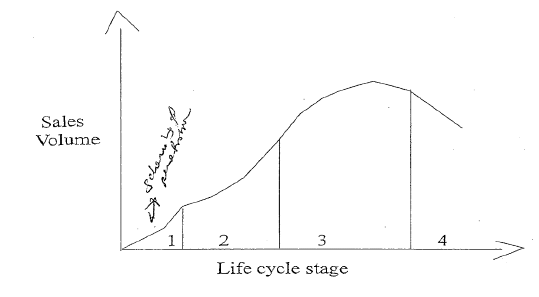1. Introduction Stage
The introductory stage starts where commercialization of a product stops, i.e. at the end of the new product development stage. At this stage, profits are negative because of low sales and heavy distribution and promotion expenses. The firms with products at this stage experience high costs of production, net losses, and limited distribution and coverage for the products It is a very risky and an expensive stage.
Products have life cycles that can be divided into four stages namely;

i) Introductory
ii) Growth
iii) Maturity
iv) Decline
Competition is low because of few competitors who sell same versions of the product. Attention is focused on consumers who are most ready to buy, usually, the high income, innovators. Prices tend to be high due to cost of production, technological problems and need for higher margins to support future production. Marketers have to concentrate scheming and penetration strategies.
2. Growth Stage
This stage is marked by rapid increase in sales and profits. The implication is that, the majority of consumers have not adopted the product and Since, this stage is the most attractive of all the PLC stages, competitors are attracted into the market. The increased competition leads to wider distribution, and factory costs of operation may rise.
Prices may fall or remain stable depending on - the industry’s cost structure. Promotion expenditure may be lowered or raised to meet the level of competition. Marketers, therefore, concentrate on strategies like improvement of quality, modification and addition of more attributes to the product.
3. Maturity Stage
This is a stage where the market gets to a mature stage. That is, the market/consumers are well aware of the product being sold in the market. The rate of growth in sales will slow down as production matures. That is, the level of sales and profits will increase but, at a declining rate. Profits may level out.
Due to this, the level of competition may decrease in the industry because sales are not growing and firms are no longer attracted into the market. The maturity stage lasts longer than any of the stages in the life history of a product. Therefore, marketers may concentrate on product improvement, modification and addition of more attributes,
4. Decline Stage
This is the last stage in the PLC. Sales decline due to overcapacity, technological advances, differing tastes and preferences, e.t.c. The result of this is, profit erosion and firms may close down. Firms that may remain may limit their production capacity because the market has shrunk. Marketers should therefore, use strategies like holding, increasing investment and divesting from the business or shrinking the level of business.
Titany answered the question on
October 6, 2021 at 12:51